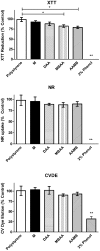Nanometer scale titanium surface texturing are detected by signaling pathways involving transient FAK and Src activations
- PMID: 24999733
- PMCID: PMC4085036
- DOI: 10.1371/journal.pone.0095662
Nanometer scale titanium surface texturing are detected by signaling pathways involving transient FAK and Src activations
Abstract
Background: It is known that physico/chemical alterations on biomaterial surfaces have the capability to modulate cellular behavior, affecting early tissue repair. Such surface modifications are aimed to improve early healing response and, clinically, offer the possibility to shorten the time from implant placement to functional loading. Since FAK and Src are intracellular proteins able to predict the quality of osteoblast adhesion, this study evaluated the osteoblast behavior in response to nanometer scale titanium surface texturing by monitoring FAK and Src phosphorylations.
Methodology: Four engineered titanium surfaces were used for the study: machined (M), dual acid-etched (DAA), resorbable media microblasted and acid-etched (MBAA), and acid-etch microblasted (AAMB). Surfaces were characterized by scanning electron microscopy, interferometry, atomic force microscopy, x-ray photoelectron spectroscopy and energy dispersive X-ray spectroscopy. Thereafter, those 4 samples were used to evaluate their cytotoxicity and interference on FAK and Src phosphorylations. Both Src and FAK were investigated by using specific antibody against specific phosphorylation sites.
Principal findings: The results showed that both FAK and Src activations were differently modulated as a function of titanium surfaces physico/chemical configuration and protein adsorption.
Conclusions: It can be suggested that signaling pathways involving both FAK and Src could provide biomarkers to predict osteoblast adhesion onto different surfaces.
Conflict of interest statement
Figures







Similar articles
-
Nano hydroxyapatite-blasted titanium surface creates a biointerface able to govern Src-dependent osteoblast metabolism as prerequisite to ECM remodeling.Colloids Surf B Biointerfaces. 2018 Mar 1;163:321-328. doi: 10.1016/j.colsurfb.2017.12.049. Epub 2017 Dec 28. Colloids Surf B Biointerfaces. 2018. PMID: 29329077
-
Nano hydroxyapatite-blasted titanium surface affects pre-osteoblast morphology by modulating critical intracellular pathways.Biotechnol Bioeng. 2017 Aug;114(8):1888-1898. doi: 10.1002/bit.26310. Epub 2017 Jun 7. Biotechnol Bioeng. 2017. PMID: 28401535
-
Titanium-released from dental implant enhances pre-osteoblast adhesion by ROS modulating crucial intracellular pathways.J Biomed Mater Res A. 2017 Nov;105(11):2968-2976. doi: 10.1002/jbm.a.36150. Epub 2017 Jul 14. J Biomed Mater Res A. 2017. PMID: 28639351
-
Integrin-regulated FAK-Src signaling in normal and cancer cells.Curr Opin Cell Biol. 2006 Oct;18(5):516-23. doi: 10.1016/j.ceb.2006.08.011. Epub 2006 Aug 17. Curr Opin Cell Biol. 2006. PMID: 16919435 Review.
-
Biological nano-functionalization of titanium-based biomaterial surfaces: a flexible toolbox.J R Soc Interface. 2010 Feb 6;7 Suppl 1(Suppl 1):S93-S105. doi: 10.1098/rsif.2009.0418.focus. Epub 2009 Nov 4. J R Soc Interface. 2010. PMID: 19889692 Free PMC article. Review.
Cited by
-
Titanium-Enriched Medium Promotes Environment-Induced Epigenetic Machinery Changes in Human Endothelial Cells.J Funct Biomater. 2023 Feb 27;14(3):131. doi: 10.3390/jfb14030131. J Funct Biomater. 2023. PMID: 36976055 Free PMC article.
-
OsteoBLAST: Computational Routine of Global Molecular Analysis Applied to Biomaterials Development.Front Bioeng Biotechnol. 2020 Oct 8;8:565901. doi: 10.3389/fbioe.2020.565901. eCollection 2020. Front Bioeng Biotechnol. 2020. PMID: 33117780 Free PMC article.
-
Argon plasma modification promotes adipose derived stem cells osteogenic and chondrogenic differentiation on nanocomposite polyurethane scaffolds; implications for skeletal tissue engineering.Mater Sci Eng C Mater Biol Appl. 2019 Dec;105:110085. doi: 10.1016/j.msec.2019.110085. Epub 2019 Aug 26. Mater Sci Eng C Mater Biol Appl. 2019. PMID: 31546386 Free PMC article.
-
Effect of focal adhesion kinase inhibition on osteoblastic cells grown on titanium with different topographies.J Appl Oral Sci. 2020 Feb 7;28:e20190156. doi: 10.1590/1678-7757-2019-0156. eCollection 2020. J Appl Oral Sci. 2020. PMID: 32049134 Free PMC article.
-
Differential Effects of Nano TiO₂ and CeO₂ on Normal Human Lung Epithelial Cells In Vitro.J Nanosci Nanotechnol. 2019 Nov 1;19(11):6907-6923. doi: 10.1166/jnn.2019.16737. J Nanosci Nanotechnol. 2019. PMID: 31039842 Free PMC article.
References
-
- Raes F, Cooper LF, Tarrida LG, Vandromme H, De Bruyn H (2012) A case-control study assessing oral-health-related quality of life after immediately loaded single implants in healed alveolar ridges or extraction sockets. Clinical oral implants research 23: 602–8 10.1111/j.1600-0501.2011.02178.x - DOI - PubMed
Publication types
MeSH terms
Substances
LinkOut - more resources
Full Text Sources
Other Literature Sources
Molecular Biology Databases
Miscellaneous

